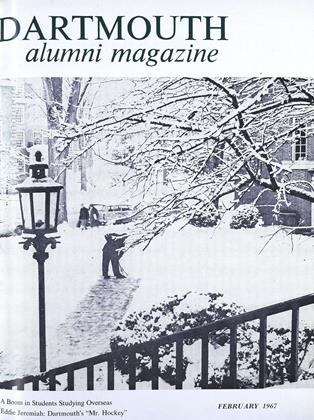By Sanborn C.Brown '35. New York: John Wiley & Sons, 1966. 286 pp. $9.95.
Professor Brown's book once again calls attention to the recent increased interest and activity concerning the behavior of ionized gases or plasmas. It is almost a commonplace to note that most of space beyond the earth's surface is permeated by plasma and that the plasma medium also is thought to provide the best hope for achieving controlled thermonuclear reactions for power production purposes. Although these more or less applied aspects of ionized gas physics have fueled much of the recent flare of interest, it is important and useful to note that this field of research has a long, illustrious history. Indeed, during the last of the 1800's and early 1900's the study of ionized gases resulted in the identification of such fundamental constituents of matter as the electron and proton.
In spite of this early activity, the total effort in this field had dropped to a rather low level by the 1930's. From about 1930 until 1950, very few laboratories in the world were engaged in plasma physics research. One of these few was located at the Massachusetts Institute of Technology. Professor Brown has been a distinguished, longterm contributor to the work of that laboratory, The present volume is but one of several which Professor Brown has produced that deal with the fundamental processes in ionized gases. Much of the flavor of his own work and that of his associates is evident in all of these works; this has real merit since their contributions have been of such value to the rest of us who work with plasmas.
The present volume was written as a text for use by advanced undergraduate and beginning graduate students. As such, some mathematical ability is presumed but this is clearly a book by an experimental physicist and intended primarily for other experimental physicists. Actual laboratory measurements and data are stressed; there is hardly a page without an apparatus diagram or a data plot. This is good. One too seldom sees such unabashed enthusiasm for the actual testing ground of physics research.
The book begins with a series of chapters that are mainly devoted to what has become known as "transport properties." These chapters deal with the manner in which the ions and electrons of the ionized gas are able to move under the action of various applied force fields. A basic reason for studying ionized gases is that they provide such a wonderful medium for observing the ways in which many separate particles can interact to produce an over-all observable effect. The transport properties of diffusion, mobility, conductivity, etc. provide secure testing grounds for the theory of such manybody interactions.
A second part of the book deals with the various mechanisms that operate in the formation of an ionized gas. Clearly, if one is to form such a material, it is essential to remove some electrons from some atoms. This removal is called ionization and is ordinarily accomplished by applying electric fields of one sort or another to a neutral gas and allowing the multiplicative effects of a chance, free electron to bring the level of ionization to the desired level. Brown treats in considerable detail the most important mechanisms that serve to help and inhibit this process.
A third portion describes the state of affairs once the ionization and recombinaion processes have settled down into a steady state; and a fourth part treats the interactions of plasma with electromagnetic wave fields. The last chapter deals with a particularly interesting case of these electromagnetic interactions. These are the so-called "plasma oscillations" in which the electron component of the ionized gas oscillates about the relatively more massive positiveion component. A few aspects of these plasma oscillations were known in the 1920's due primarily to the work of Irving Langmuir and Lewis Tonks, but the trail of research on this effect has been long and has led from the General Electric Research Laboratory through MIT, Sweden, Cal. Tech. and many other places before the present understanding described by Dr. Brown was reached.
Professor Brown is to be complimented and thanked for his latest contribution to the literature of ionized gas physics. This book will be useful to students and mature researchers alike.
Professor of Physics and Astronomy
 View Full Issue
View Full Issue
More From This Issue
-
 Feature
Feature"Mr. Hockey" By General Acclaim
February 1967 By CLIFFORD L. JORDAN JR. '45 -
 Feature
FeatureNous Étudiants à l'Étranger
February 1967 -
 Feature
FeatureMammalogist
February 1967 -
 Feature
FeatureSports Style-Setter
February 1967 -
 Feature
FeatureInternational Catalyst
February 1967 -
 Feature
FeatureCongressional Chronicler
February 1967
Books
-
 Books
BooksFACULTY PUBLICATIONS
October 1919 -
 Books
BooksBriefly Noted
NOVEMBER 1967 -
 Books
BooksJAPAN'S IMPERIAL CONSPIRACY: HOW EMPEROR HIROHITO LED JAPAN INTO WAR AGAINST THE WEST.
JANUARY 1972 By DONALD Bartlett'24 -
 Books
BooksGUIDANCE IN CATHOLIC COLLEGES AND UNIVERSITIES. Edited
October 1949 By Howard F. Dunham '11 -
 Books
BooksUSING INFORMATION TO MANAGE.
FEBRUARY 1969 By J.M. TURNER. PH.D. THAYER '66 -
 Books
BooksDARTMOUTH SONG BOOK
April 1950 By JUD LYON '4O


